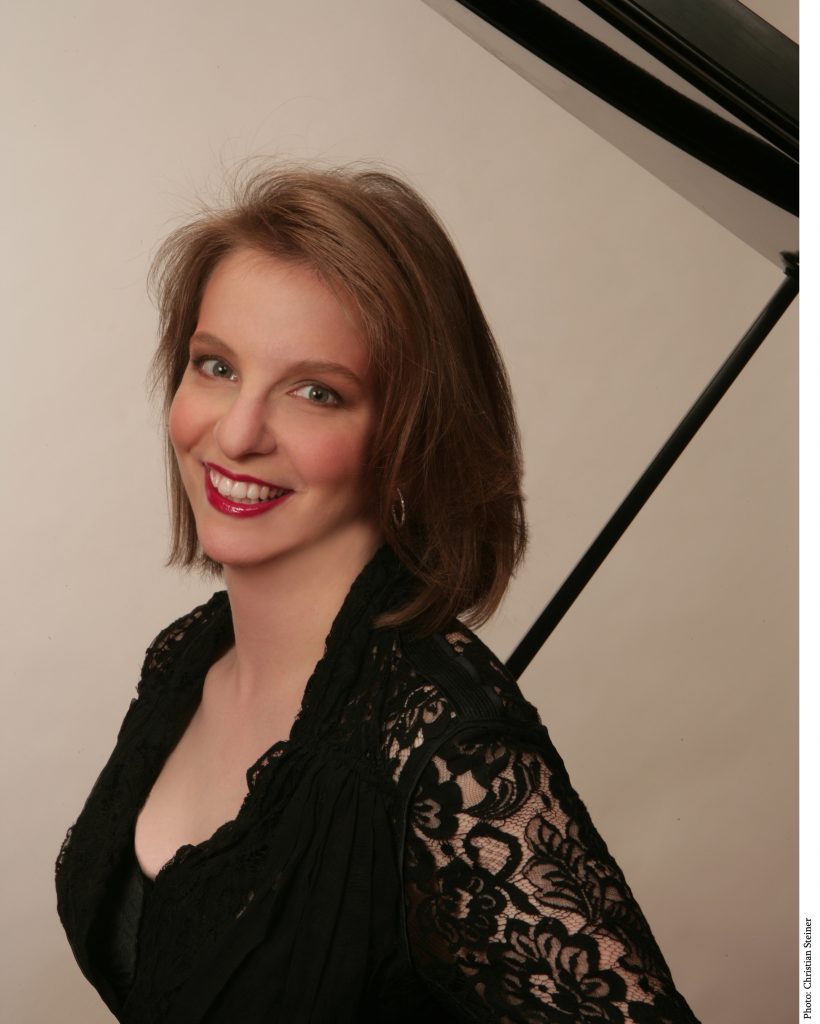Pianist Orli Shaham Thrills in Bernstein’s “The Age of Anxiety” with the San Diego Symphony
Continuing the San Diego Symphony’s laudable Leonard Bernstein year-long centennial salute, guest conductor Steven Sloane and the orchestra offered a rousing account of Bernstein’s Symphony No. 2, “The Age of Anxiety,” Friday, November 16, at Copley Symphony Hall. Although the composer called this work a symphony, it looks and sounds like a piano concerto, and guest pianist Orli Shaham gave its virtuoso part the bravura attention and flash it requires.

Orli Shaham [photo (c.) Christian Steiner]
In the work’s fifth section, most of the orchestra sat silently while the piano soloist, a bassist and members of the percussion section engaged in an upbeat, extensive jazz-inflected fantasia. While members of the woodwinds adjusted and fiddled with their reeds in this section, I half expected the string players near the edge of the stage to sneak backstage for a quick smoke or email check on their cell phones.
“The Age of Anxiety” does not impress me as strongly as Bernstein’s “Jeremiah” Symphony or his Serenade (his violin concerto), each performed by the orchestra in the spring of 2018, but it is as worthy of a regular airing as, say, Robert Schumann’s Piano Concerto in A Minor. And we should not wait for another centennial to bring it out again.
Sloane opened his Bernstein salute with “Lenny,” the late Israeli composer Noam Sheriff’s affectionate

Steven Sloane [photo (c.) Marcus Witte]
Programming the Orchestral Suite from “Appalachian Spring,” the most popular work by another Bernstein colleague and mentor, Aaron Copland, also proved canny. It was telling to compare Copland’s modest, spare themes in their crystalline orchestrations—not to mention the structural discipline of a composer who studied composition with Nadia Boulanger—with Bernstein’s athletic, angular themes and his rhapsodic indifference to structural niceties.
For the “Appalachian Spring” ballet that Copland composed for dance guru Martha Graham in 1944—scored only for 13 instruments because of the small pit in the hall in which Graham and her troupe premiered the dance—Copland received the 1945 Pulitzer Prize for Music. At the urging of several prominent American conductors, Copland arranged the ballet into a Suite for full orchestra, not surprisingly first recorded by Koussevitsky and the Boston Symphony in 1945.
Vigorously leading the Copland, Sloane nevertheless took no detail for granted as the orchestra gave him an unusually splendid, glowing account of this pellucid icon of progressive American music in the 1940s. As usual, the first chair woodwinds outdid themselves turning out and trading one sparkling, adroitly shaped theme after the other. The orchestra’s masterful performance even persuaded me to forgive Copland for scoring his final variation of the Shaker hymn “Simple Gifts” in a grandiose fashion that brought to mind Moussorgsky’s climactic moments of “The Great Gate of Kiev.” Not so simple at all.
As the Copland Suite gently cadenced, Sloane cleverly moved right into Charles Ives’ popular but by no means populist “The Unanswered Question.” He managed to keep the all the string sections at an ethereal pianissimo murmur, while a quartet of flutists battled with Ives’ bristling counterpoint and a solitary trumpet in the highest balcony announced Ives’ perplexing musical “question.” These disparate elements merged with the precision Ives intended, much to the delight of the San Diego audience. And it was noted that as a conductor, Bernstein was a staunch advocate of Ives’ music, especially when Ives was little noticed on American symphony programs.
This concert by the San Diego Symphony was presented on Friday, November 16, 2018, in the Jacobs Music Center’s Copley Symphony Hall. It will be repeated in the same venue on Saturday, November 17, 2018.

Ken Herman, a classically trained pianist and organist, has covered music for the San Diego Union, the Los Angeles Times’ San Diego Edition, and for sandiego.com. He has won numerous awards, including first place for Live Performance and Opera Reviews in the 2017, the 2018, and the 2019 Excellence in Journalism Awards competition held by the San Diego Press Club. A Chicago native, he came to San Diego to pursue a graduate degree and stayed.Read more…



Love “Age of Anxiety” but have trouble with Auden plus “Age.” Review avoids this angst. Thank you.
Does the program of a musical work always matter? I have been to Prague and seen the Vltava River from the Charles Bridge, but it didn’t yield a single insight about Smetana’s “Moldau” tone poem.
Does it ever matter?
KMW: Sometimes, yes. Knowing about the actual paintings in Moussorgsky’s “Pictures at an Exhibition” is elucidating, and knowing some of the events depicted in the Richard Strauss tone poems makes them more endurable.